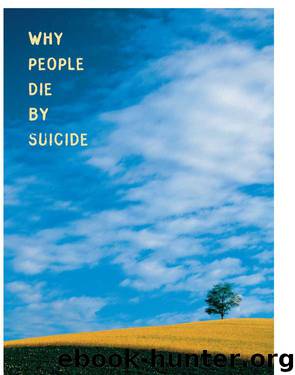Why People Die By Suicide by Thomas Joiner

Author:Thomas Joiner [Joiner, Thomas]
Language: eng
Format: epub
ISBN: 9780674019010
Published: 2005-09-08T12:28:54+00:00
WHAT DO WE
MEAN BY SUICIDE?
HOW IS IT
DISTRIBUTED
IN PEOPLE?
4
In the previous chapter, I asserted that those who desire suicide die by
suicide only if they can. Those who can die by suicide will die only if
they want to. But who can? Those who have acquired the capability to
enact lethal self-injury. Who wants to? Those who perceive that they are
a burden on loved ones and that they do not belong to a valued group or relationship. There are relatively large numbers of people who desire
suicide, and large numbers of those who have developed the capacity for
suicide. But there are relatively few people in the dangerous convergence
zone—those who are at greatest risk for serious suicidal behavior.
The components of the model have some interesting relation-
ships to each other. The interrelations of burdensomeness and low
belongingness have been discussed, but what of the associations be-
tween acquired ability for suicide, on the one hand, and burden-
someness and low belongingness, on the other hand? In fact, there is
evidence that social isolation may lead to increases in pain tolerance.
Researchers have shown that the pain threshold of mice increases af-
ter thirty days of isolation.1 Sensory deprivation increases the pain
threshold in people as well.2
137
138 ● WHY PEOPLE DIE BY SUICIDE
Those who desire suicide:
Those who are
Perceived burdensomeness
capable of suicide
+
Failed belongingness
Serious attempt or death by suicide
Just as isolation may lead to the ability to bear increased pain,
behaviors that increase the pain threshold may lead to isolation.
Provocative behaviors, like self-injury, can be off-putting. These be-
haviors can also lead others to perceive one as a burden. In one
study, a majority of the significant others of those who had re-
cently attempted suicide reported that their support of the patient
represented a burden to them.3 If people who engage in self-harm
are ostracized and viewed as a burden because of it, their sense of
belongingness may diminish and their sense of perceived burden-
someness may increase. In a number of ways, then, components of
the model presented here may feed each other. Any one of the com-
ponents could be viewed as an entry into a process whereby all
three components, and thus high risk for serious suicidal behavior,
escalate.
Any persuasive explanation of suicide should shed at least some
light on the existing data, including prevalence; the clustering and
“contagion” of suicide; and the associations of suicide with age, gen-
der, race, neurobiological indices, mental disorders, substance abuse,
impulsivity, and childhood adversity. The present model may also
contribute to the resolution of long-standing dilemmas in the field
of suicide research, treatment, and prevention, and explain some
What Do We Mean by Suicide? ● 139
puzzling suicide-related facts. For example, what constitutes a proper
definition of suicide itself? Are mild suicidal ideation and lethal sui-
cidal behavior located at different points along the same underly-
ing continuum, or are they categorically different phenomena? The
model may help us think about what we mean by suicide.
Definitions of Suicidal Behavior
A man is discovered dead in his car, which has veered off the road
and slammed into a tree. There are no skid marks and alcohol is in
his system, though not at levels exceeding the legal limit. Family and
friends state that he has
Download
This site does not store any files on its server. We only index and link to content provided by other sites. Please contact the content providers to delete copyright contents if any and email us, we'll remove relevant links or contents immediately.
| Grief & Bereavement | Hospice Care |
| Pet Loss | Suicide |
They Both Die at the End by Adam Silvera(9720)
Thirteen Reasons Why by Jay Asher(8790)
The Space Between by Michelle L. Teichman(6853)
Suicide Notes by Michael Thomas Ford(4750)
Tuesdays with Morrie by Mitch Albom(4683)
Suicide: A Study in Sociology by Emile Durkheim(2971)
The Checklist Manifesto by Atul Gawande(2775)
Tuesdays With Morrie by Mitch Albom(2681)
In the Woods by Tana French(2529)
Bossypants by Tina Fey(2463)
Robin by Dave Itzkoff(2381)
Olive Kitteridge by Elizabeth Strout(2306)
No Ashes in the Fire by Darnell L Moore(2296)
Reservoir 13 by Jon McGregor(2239)
End of Days by Sylvia Browne(2113)
All Things New by John Eldredge(2102)
Bus on Jaffa Road by Mike Kelly(2101)
Scar Tissue by Anthony Kiedis(2089)
No Time to Say Goodbye(2054)
